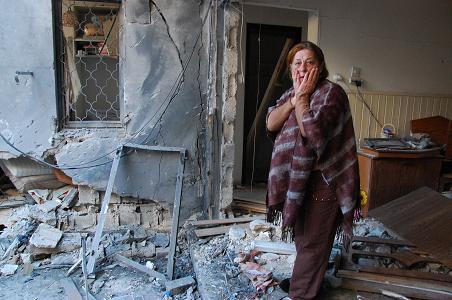This past August, I traveled to Winnipeg, Canada to talk about the twisted reality that Sderot residents continue to endure even during the relative calm of the third Hamas-Israel ceasefire. Winnipeg is home to about 15,000 Jews, and throughout my trip I met many dedicated supporters of the state of Israel.
During my two day stay, I was hosted by a special couple whose quiet dedication to Sderot and the Jewish people initially inspired the visit. This couple, who I know will not want to be mentioned by name in the article, are ordinary folks, retired Canadians who had visited Sderot and Kibbutz Nir Am several months before.
Sderot, also known as Missile City, has been the target of thousands of Gaza rocket attacks in the past eight years. Years of rocket explosions and sirens have devastated Sderot and Negev residents, both psychologically and economically.
Sderot woman overlooks the damage to her home after a Qassam attack during Operation Cast Lead. Photo: Noam Bedein
Consequently, countless people from all over the world have stopped to visit Sderot. In the past year, these visitors included US governors and Congressmen, presidential candidates and NBA hoop stars, as well as the mayor of New York City and US President Barak Obama before he was elected. In addition to government officials and policy makers, Sderot Media Center has also hosted suburban North American families, concerned grandparents, opinionated college students and even Joe the Plumber– who all make the trek to Missile City to show their solidarity.
However, while the tourists come and ago, the rocket reality remains. There are few visitors, who after their initial visit to Sderot, actively campaign on behalf of the region’s traumatized residents once they are safely back in their homes. Most people remember Sderot when Hamas fires rocket barrages at the city. The region tends to be forgotten during periods of relative quiet, when mainstream media no longer deems traumatized residents of Sderot newsworthy material.
In any case, this Canadian couple proved me wrong. They were so impacted by their visit to Sderot, neighboring Kibbutz Nir Am, and Kibbutz Nirim (near the Gaza border) that they decided that their friends and family back home had to be made aware of the rocket reality. During their visit to Kibbutz Nirim, the Canadian couple could not help but notice how rocket terror impacted every aspect of life. “We sat with friends on the kibbutz, drinking tea and chatting, not 10 meters away from an ugly concrete bomb shelter,” the husband told me.
Subsequently, the pair organized a Sderot awareness BBQ and I was invited to give a first-hand account about the Sderot reality before their friends, family members, and even neighbors.
The group of 40 Canadians sitting before me at the BBQ included bubbies and zaides, parents, lawyers, educators, and Israel activists. Although the group was somewhat familiar with the Sderot saga, almost no one had ever seen film footage or photos depicting Sderot life under rockets. In fact, for many of these Canadians, it was the first time that they had the opportunity to view exactly how southern Israelis have been impacted by Qassam attacks.
However, it was not only the older generation of Canadian Jews who I met that empathized with Sderot. My hosts’ son, in his thirties, also organized a Sderot awareness evening for his age group, including recent immigrants from the Argentinean Jewish community. In the heart of the Canadian prairies, I had discovered that there was a tidal wave of support for the residents of this region.
In addition, I also spoke with the Winnipeg Jewish Post and News and representatives from the Winnipeg Jewish Federation, also kindly arranged by my hosts.
As the international correspondent for Sderot Media Center, I’ve traveled across the world to speak before Jewish and Christian communities on the Sderot rocket situation. I’ve experienced countless rocket attacks and post-trauma of my own and have shared my experiences and the plight of Sderot residents with hundreds of people including ambassadors and government officials.
But it is the average everyday couples, like my Winnipeg hosts, who never cease to amaze me. The power of what ordinary citizens in North America and around the world can do– in order to make the reality facing ordinary Sderot citizens more widely recognized– is limitless. From letter writing campaigns to government representatives and news editors, to awareness events in local communities, these ordinary folks are some of the most important ambassadors standing up for Sderot and Israel today.










